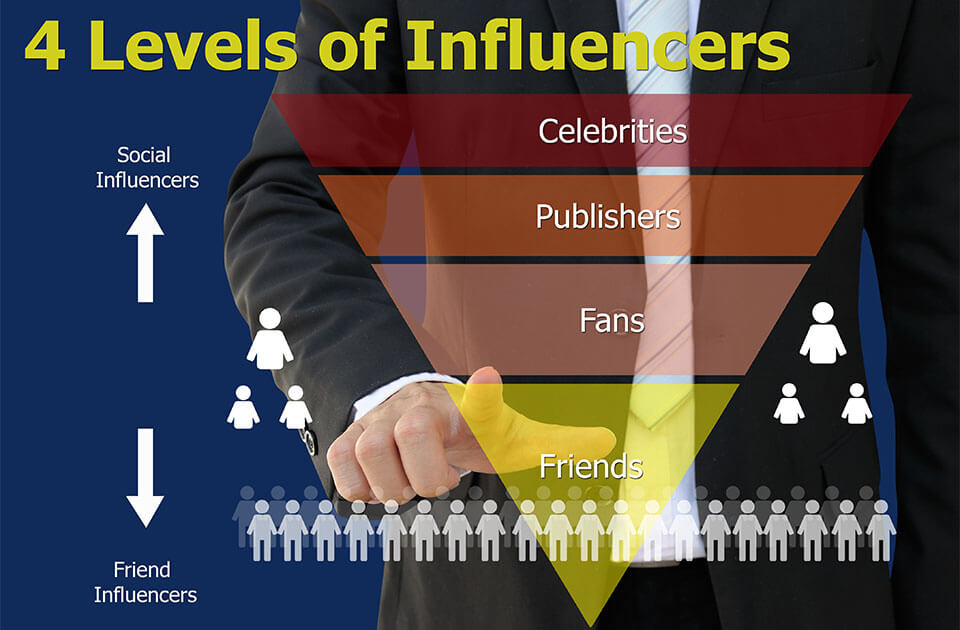Influencer marketing: finding authentic brand ambassadors
Achieving your 15 minutes of fame in the modern world can be a very quick process. Publishing a clip on YouTube, posting a tweet on Twitter, or making a comment on Facebook that touches a nerve or evokes an emotion can travel across the whole world in just a few days. But once a clip or a post ‘goes viral’, it usually disappears from the spotlight just as quickly as it arrived.
The real challenge is to make a name for yourself through expert knowledge and contacts and to then establish yourself as an opinion leader for the long term. Public figures who influence trends and opinions online and set the tone on Instagram and Co. quickly become gigantic role models for their followers. And this gives them a very big advantage: as influencers they become multiplier targets for businesses and brands online.
Using influencers online and building a successful communications strategy is known as influencer marketing, and it represents a great opportunity for companies and marketers in the online world.
What is influencer marketing?
For a long time now, influencer marketing has been much more than a simple buzzword that gets thrown around by every self-styled marketing expert. As the classic marketing strategies like online PR, referral marketing, and social media marketing cross over, this crucial new discipline has emerged as their offspring in the field of online marketing.
The main task when employing the strategy of influencer marketing is to identify relevant influencer personalities for your individual company or brand, to contact them, and to build a working relationship with them. Businesses that use influencers usually try to integrate them into their communications strategy and use them as multipliers for corporate messages and online advertising. Before we take a closer look at the mechanisms involved in successful influencer marketing, we’ll clarify what it takes to be a good social media influencer.
What is an influencer?
Influencers are basically personalities who have established themselves as opinion leaders online. They typically have a very broad reach, which they’ve usually earned as a blogger operating their own online presence, through the use social media channels like Twitter, Instagram, or YouTube, or a combination of all of the above.
An extensive reach is an influencer’s nominal capital. But reach isn’t enough on its own – social influence is the really decisive factor. Users who have built a fan base and earned credibility and trust from the online community are considered role models and so have a great influence on opinion and consumer behavior. In principle, anyone could become an influencer: journalists, bloggers, sports stars, YouTubers, public figures, politicians, authors, industry experts – there are top social media influencers from many different walks of life.
How can businesses profit from influencers?
The media landscape has changed dramatically in the past few years. Classic mediums simply don’t command the same level of influence on public opinion as they did several years back. And, above all, digital natives who have grown up in the modern technological age trust online role models for news and opinion. The reach that these ‘experts’ of different topics have is enormous, particularly when it comes to the (video) blogger scene. With millions of readers/viewers and followers, individual personalities can dominate in their field of expertise, and their opinions are highly valued by their loyal fans. Depending on the topic and focus of the influencer, companies can tap into a valuable, very well defined target market with just one simple post.
When an influencer gives tips and recommendations on products, services, or brands, fans and followers listen. They trust the judgment of their role model, eager to emulate them in whichever way they can. And this can have a profound, often subconscious effect on personal consumer behavior. Businesses acting online can use this basis of trust to multiply their own advertising messages through the help of the influencer. This turns bloggers or artists into brand ambassadors, in turn shining the spotlight on individual products or brands. A study conducted by the Nielsen Holdings PLC even went as far as to show that consumers trust personal recommendations more than any form of traditional advertising. This means that influencers can act as middlemen, getting your online business one step closer to potential customers and making sure that your products and brand get the visibility and attention you want online.
So which influencers are best suited to your company’s needs, and how do you start up a partnership with them?
Identifying influencers
Your first step as a marketer should be to find answers to these two basic questions: When does a blogger or a YouTuber become an influencer, and when does an influencer become relevant for my marketing aims? Depending on the industry and status of your company, there are many different guidelines that you can use to identify who of the numerous opinion makers online could be suitable business partners.
Here are the most important factors involved in finding the right influencers for your company:
- Activity: which channels does the influencer operate on? Where are they active and where does all their communication take place? The follower figures are the first obvious indicators, but be careful – sheer number of followers isn’t everything. When it comes to niche topics, a blog with just a few hundred dedicated readers can represent an extremely valuable target group.
- Reach within the target market: does the influencer speak to the sort of people that I want to reach with my product? There are numerous profiles and channels with impressive user figures (in fact, you can even buy followers or subscribers on some networks nowadays). But they’re only actually relevant for your company if they represent real members of your target market. So it’s not just important to check the reach of the channel – you have to make sure it’s reaching the relevant contacts too.
- Expert status: which central topics are part of your company communications strategy? Which influencers could be considered experts in these fields? Do these experts fit your company image and ethos? Are there influencers who have already built a reputation tackling similar topics and are well-known within the industry?
- Engagement: of course, it’s not just the number of fans and followers on Facebook or Twitter that count. Interaction with users and ‘community engagement’ are decisive markers when it comes to being an influencer. Retweets, comments, shares, and likes are very important indicators. They provide information about the relationship between the influencer and the community. If fans share and discuss an influencer’s posts, that’s a clear guideline for their credibility.
Influencer marketing tools
Personal communication and research are essential aspects of influencer marketing. Evaluating whether a particular influencer is right for your company doesn’t just come down to their social network figures. Deciding if the quality of their content is right for your business, or if their personal style fits your company philosophy, can’t really be determined by a machine: you have to assess these things yourself. But it goes without saying that social network figures and data are of course useful criteria to consider, particularly when compiling an initial broad list to be narrowed down later.
When it comes to measuring reach, follower/subscriber figures, and interaction rates, there are certain special tools that can help. The list of influencer marketing tools available is long – so we’ve compiled a short selection of some of the best known ones:
Klout
Klout is considered one of the best tools for influencer marketing – made famous by its popular Klout Score. On a scale of 1 to 100, Klout measures the online influence of a user based on different social media data available. The Klout Score is sometimes disputed – there are plenty of accusations of manipulation – but it remains a good initial indicator of the value of a contact.
Buzzsumo
Internationally recognized tool Buzzsumo uses data from Facebook, LinkedIn, Twitter, Pinterest, Google+, and more to provide information about potential influencers. Users can enter a keyword into the tool and it’ll return the most influential social media players that relate to the keyword in question. There are additional filters (e.g. location) that can be used to further refine a search.
Kred
Kred is a basic tool for all the important influencer metrics. Similarly to Klout, Kred offers users an influence score. This is made up of mentions, retweets, replies, and followers on Twitter.
Followerwonk
Followerwonk is part of the Moz Suite, meaning it’s available free of charge and offers users the option to search Twitter accounts for certain keywords. It’s then possible to order the results list by reach and authority. Followerwonk offers other additional analytical features: you can compare follower profiles of up to three different social media influencers, which is very useful in competition analysis and enables you to compare different networks.
Klear
Klear is a simple but effective tool for anyone who wants to identify influencers within your own network. This free solution offers you clear differentiations between influencer types.
All of the influencer marketing tools above provide a good introduction into influencer marketing. They give you practical scores and relevant figures that are easy to process. But they are limited when it comes to analysis. If you want to take influencer analysis one step further, there are two solutions. The first is to use the help of a professional social media monitoring tool, programs that contain integrated functions for influencer identification.
The alternative option is to make use of a third party influencer marketing company. These influencer marketers do the leg work for you, offering you comprehensive networks of influencers to choose from. These firms will find the right influencer(s) to match your brand, product, approach, and budget. Examples of these include Digital Brand Architects and Socialyte, both of which are based in the USA and preside over a global network of influencers. When it comes to the UK market and Europe, Brandnew offers a platform for all social networks, specializing in the British market but has influencers across the globe.
Influencer relations: contact at eye level
So now we’ve established what the term influencer actually means and how to identify which ones could be suitable as relevant multipliers for your marketing strategy. But now comes the biggest challenge: convincing your chosen influencer(s) to work with you.
Avoid sand traps
Almost every blogger and YouTube star with a decent fan base is already aware of his/her influence and subsequent market value. In fact, particularly well-known figures, especially those in the YouTube scene, will often have their own professional image management. Even less famous influencers are picky when it comes to choosing partnerships and campaigns. This is where companies have to tread slightly carefully. The worst thing you can do here is to give the influencer the feeling that you are trying to ‘buy’ them. Any attempts to try and coax influencers will be identified and result in talks breaking down. Remember, you aren’t using an influencer, you’re collaborating with an individual in a partnership. Show them respect: no manipulation, no suggestion.
Influencers are typically creative in what they do. Whether it’s posting tutorial videos on YouTube, artistic photographs on Instagram, or opinionated discussions on Facebook, they will usually reflect their own personality, style, and flair in every post. As a marketer, you have to respect this and allow them as much control as possible over their posts. If you try to take charge of all aspects of the partnership, it will feel like a dictatorship and you will find the end results disappointing.
Another mistake that businesses often make is undervaluing the worth of the influencer. In the past, it was very typical to try and operate an influencer marketing campaign on a shoestring. But, as we’ve mentioned already, the vast majority of influencers are fully aware of their market value, even those who aren’t represented by a management team/agency. And they know full-well that the party who will end up profiting most from the collaboration is the company, not the blogger or Instagramer. Be sure to budget properly and enter into negotiations with an adequate payment offer in mind.
Honesty and benefits
Honest and transparent communication is very important in influencer marketing. As a company, you should avoid any illusions, especially in thinking of the influencer as anything more than a partner. Building a business relationship at eye level means offering the blogger or YouTuber actual added value and advantages. What do influencers want? In a nutshell, they want to increase their fan base and their influence further. If you want to build a happy and effective partnership, you should offer them all the tools you have to help this: give them exclusives to share, like information ahead of time or brand new prototypes of products. Many big companies also run organized blogger events too.
Personal contact
When it comes to making and keeping contact with influencers, the most successful channel is still the classic e-mail, followed by Twitter. Another important point of contact is on the influencer’s blog if they run one. Telephone contact and other networks like Facebook or Google+ have proven to be less effective. The most important thing is to ensure you make personal contact directly to the individual. Don’t bombard them with e-mails and don’t send anything impersonal. Avoid going straight in with a series of ad requests – instead, just explain the background behind the enquiry and briefly outline your intentions, with reference to where you came across the influencer in the first place. By presenting yourself personally to your potential partner, you can give a warm impression that indicates openness, honesty, and a genuine interest in a long-term, mutually beneficial collaboration.
Successful influencer marketing
There’s more to a successful influencer marketing campaign than the reputation and reach of your chosen blogger or Instagram celebrity. Ensuring an influencer matches your topic, style, approach, and target audience are cornerstones to finding a good fit. But it’s equally important to make sure that the influencer feels happy working with you. This is achieved through an honest, open approach, a fair compensation for their efforts, and treatment of the working relationship as a partnership. Remember to think of influencers as brand ambassadors – they are representing you and helping you to massively increase your reach, so treat them with full respect and give them the creative license to talk about your brand or display your product in a way that matches their usual style of output online. If a post looks like it’s coming from an influencer out of choice, showcased in their individual way, it’ll be much more authentic and have a far more positive influence on public opinion and consumer behavior.
By treating your influencers as partners in a fair and open process, you’ll ensure a fruitful campaign that will profit both parties in the long term.










